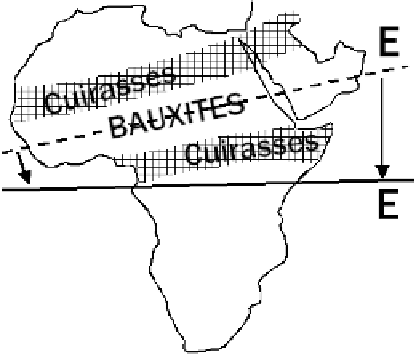Geoscience Reference
In-Depth Information
existed, because ferruginous and gibbsitic nodules are often present,
and seem to be slowly disappearing by dissolution (Boulet
et al.
1993).
In the soil mass, iron is chiefly in the form of goethite. Sometimes, in
their middle horizons, the soils are more or less orange or light red
(Yellow-Red Latosols). Haematite and goethite are present together.
5.5
EVOLUTION OF FERRALLITIC ENVIRONMENTS
5.5.1 Climatic Changes
The periods of pedogenesis in the tropical environment have been so
long that it is necessary to consider continental drift and its climatic
implications (Fig. 5.9, after Tardy and Roquin 1992).
Thus the Sahelian zone earlier was under very humid climates,
which became progressively drier with the movement of Africa below
the Equator. In this region, ferruginous accumulations tend to invade the
bauxitic profiles. Further south, the cuirasses of the present-day equatorial
zone would be under destruction. At the same time, Amazonia has an
increasingly humid climate. The ferruginous cuirasses are disappearing
there and bauxitization could take over. But superposed over these basic
trends are other more rapid and poorly understood climatic changes.
The intertropical zones are in this way mantled with soil covers more or
less in disequilibrium with the present-day climate (Boulet
et al.
1993).
Fig. 5.9
Displacement of the equator (E) in Africa since 70 million years ago. We see the
zone in which bauxites could have formed in the Cretaceous as well as two bands that were
favourable for cuirassement in the same epoch (Tardy and Roquin 1992).

